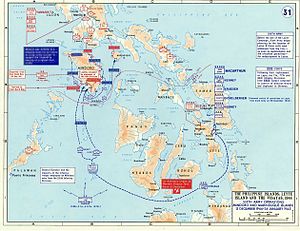Battle of Mindoro
| Battle of Mindoro | |||||||
|---|---|---|---|---|---|---|---|
| Part of the Pacific Theater of World War II | |||||||
| |||||||
| Belligerents | |||||||
| Commanders and leaders | |||||||
|
|
| ||||||
| Strength | |||||||
| 10,000 American troops | 1,200 Japanese troops | ||||||
| Casualties and losses | |||||||
|
151 killed (18 Army, 133 Navy) 271 wounded (81 Army, 190 Navy) |
~200 dead 15 captured 375 wounded | ||||||
The Battle of Mindoro (
Troops of the United States Army, supported by the United States Navy and U.S. Army Air Forces (USAAF), made an amphibious landing on Mindoro and defeated Imperial Japanese Army (IJA) forces there. There was no significant opposition from the Imperial Japanese Navy, nor from the Japanese Army and Navy Air Forces, except for kamikaze (suicide) attacks on American ships.
The Japanese force in Mindoro was not large, and was eliminated in three days. The Army was assisted in the campaign by
The U.S. captured Mindoro to establish airfields there, which would be in
Background
For the invasion of Luzon, U.S. forces needed air bases that were closer to the northern island than
The airfields recently constructed at Leyte were deemed unreliable, so potential additional airfields in Mindoro appealed to
But taking Mindoro was a daunting task. The northeastern coast was best suited for amphibious landings, but was exposed to what was left of Japanese air power on Luzon, so this was ruled out. The town of San Jose on the southwest corner, though nearer to Mangarin Bay, Mindoro's best deepwater port, was the spot chosen by his planners.
The
The main threat to the amphibious assault vessels and supporting warships was land-based Japanese kamikaze planes. The Japanese had begun the deadly practice as a desperate measure during the final stages of the Battle of Leyte and widened its use by December 1944.
In early December, USAAF and USN airplanes attacked Japanese air bases to destroy potential kamikazes before they could attack. U.S. aviators claimed more than 700 planes destroyed on the ground.
On 13 December 1944, two days before the scheduled assault on the island, kamikazes struck at the Navy task force bringing the landing force. The
Battle

On 15 December, the invasion of Mindoro began. The clear weather allowed the full use of American air and naval power, including six escort carriers, three battleships, six cruisers and many other support warships against light Japanese resistance. Because of inadequate airstrip facilities in Leyte, the 503rd Parachute Regimental Combat Team came ashore in Mangarin Bay with the landing force instead of jumping. Destroyers provided fire support for the troop landings and anti-aircraft protection for the ships in the transport area. Two LSTs struck by kamikazes were abandoned and sank.
In one heroic action, the
There were 1,000 defending Japanese soldiers stationed on Mindoro. Another 200 survivors from ships sunk off Mindoro en route to Leyte were also present. The defenders were outnumbered and outgunned. Some 300 Japanese manning an air raid warning station at the island's northern end put up a stiff fight against a company of the 503rd, but except for mopping up, the island was secure within 48 hours.
Aftermath
The defending Japanese forces on Mindoro suffered some 200 killed and 375 wounded. The survivors fled into the jungles, where they lurked till the end of the war. The 24th Infantry Division lost 18 men and had 81 wounded.
By the end of the first day, Army engineers were at work preparing airfields. Two were completed in thirteen days. These airfields allowed U.S. aircraft to provide direct support for the Luzon invasion. The Mindoro airfields were also used by long-range bombers, especially USAAF
References
- Sandler, Stanley. World War II in the Pacific: An Encyclopedia (Military History of the United States) (2000) New York Routledge ISBN 0-8153-1883-9
Further reading
- Andrade, Dale (1979). Luzon. The U.S. Army Campaigns of World War II. United States Army Center of Military History. CMH Pub 72-28. Archived from the original on 2008-12-15. Retrieved 2010-08-12.
- "Chapter IX: The Mindoro and Luzon Operations". Reports of General MacArthur: The Campaigns of MacArthur in the Pacific: Volume I. Library of Congress: Department of the Army. pp. 242–294. Archived from the original on 16 January 2014. Retrieved 5 January 2014.
